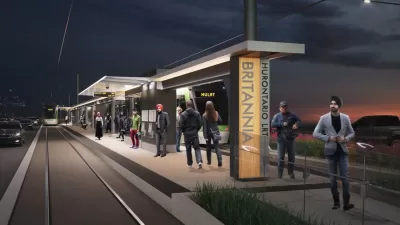This week, the Toronto region's transportation agency floated a strategy for how to fund the wildly ambitious 25-year transportation plan know as the Big Move. A combination of new taxes and fees are expected to yield $2 billion per year.
"It will cost the average Toronto region household an additional $477 a year in taxes to overcome a generation of public transit neglect and crippling road congestion under a transit investment strategy being unveiled by Metrolinx on Monday," reports Tess Kalinowski. "The Toronto Star has learned that the provincial transportation agency is recommending a 1 per cent sales tax, 5-cent/litre gas tax, a 25-cent-per-day non-residential parking levy and a 15 per cent hike in development charges to raise just over $2 billion annually."
"That’s the cost of building the Metrolinx 25-year, $50-billion Big Move transportation plan. It calls for more than triple the region’s 500 km of rapid transit to about 1,700 km and would put a transit stop within 2 km of 75 per cent of residents."
In an article in Torontoist, Steve Munro takes a deep look at the history and details behind Metrolinx's Investment Strategy [PDF]. He also ruminates on its prognosis for passage. "Metrolinx and Queen’s Park face a considerable political challenge in convincing Ontario residents that new taxes will bring meaningful, timely improvements to their travel experience. Polls and community meetings suggest that everyone—including the business community—accepts the need for greater transit spending, but the preferred source is often 'anyone but me.'”
"The new taxes will place varying burdens on different groups, but these will be eventually offset by the transfer of personal expenses (eliminating a second or third car, reducing the time needed to commute) to public ones. That 'eventually' is the nub of Metrolinx’s problem. Voters will pay for many years before they benefit from better transit, and those years must see plans and funding survive swings in government policy and economic activity."
"In its staging plan, Metrolinx must show how improvements will be felt in the near and medium term, not just in a hypothetical future where all of The Big Move is in operation."
FULL STORY: Metrolinx backs hikes in HST, gas tax and new parking levy

Planetizen Federal Action Tracker
A weekly monitor of how Trump’s orders and actions are impacting planners and planning in America.

The Simple Legislative Tool Transforming Vacant Downtowns
In California, Michigan and Georgia, an easy win is bringing dollars — and delight — back to city centers.

San Francisco's School District Spent $105M To Build Affordable Housing for Teachers — And That's Just the Beginning
SFUSD joins a growing list of school districts using their land holdings to address housing affordability challenges faced by their own employees.

In More Metros Than You’d Think, Suburbs are Now More Expensive Than the City
If you're moving to the burbs to save on square footage, data shows you should think again.

The States Losing Rural Delivery Rooms at an Alarming Pace
In some states, as few as 9% of rural hospitals still deliver babies. As a result, rising pre-term births, no adequate pre-term care and "harrowing" close calls are a growing reality.

The Small South Asian Republic Going all in on EVs
Thanks to one simple policy change less than five years ago, 65% of new cars in this Himalayan country are now electric.
Urban Design for Planners 1: Software Tools
This six-course series explores essential urban design concepts using open source software and equips planners with the tools they need to participate fully in the urban design process.
Planning for Universal Design
Learn the tools for implementing Universal Design in planning regulations.
Smith Gee Studio
City of Charlotte
City of Camden Redevelopment Agency
City of Astoria
Transportation Research & Education Center (TREC) at Portland State University
US High Speed Rail Association
City of Camden Redevelopment Agency
Municipality of Princeton (NJ)




























